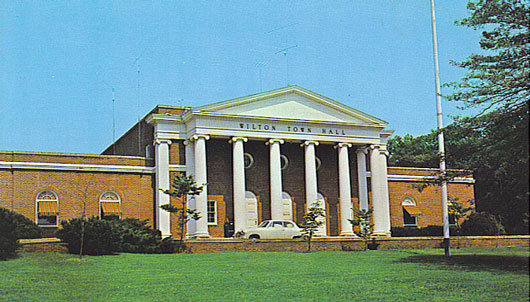Wilton Town History
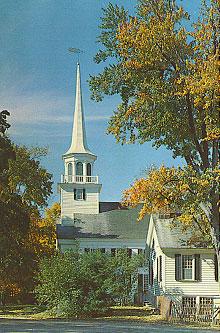
Wilton is a residential town rich in New England history. The first written records of the areas that are now Wilton date back to 1640, when Roger Ludlow and his friends purchased land from the Indians between the Norwalk and Saugatuck Rivers and "a day's walk into the country." This land was called Norwalk.
The first settlers, called the Proprietors, arrived in Norwalk in 1651 and owned 50,000 acres in common. On the outskirts of Norwalk's settled area, the Proprietors were allowed private ownership of acreage in a common planting field, but cattle, sheep, and hogs were grazed in a communal pasture area. The outer limit of this pasture approximates Wilton's present southern boundary.
By the end of the seventeenth century, the Norwalk Proprietors began to sell off the northern lands for settlement. The first non-Indian settlements in what is now Wilton were in the fertile lands of the Norwalk River valley, and on the ridges of Belden Hill, Chestnut Hill, and Ridgefield Road. In order to till the lands, the settlers had to clear the forests and remove hundreds of glacial rocks, which became the stone boundary walls that we treasure today.
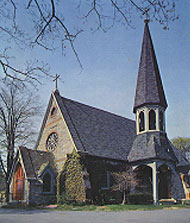
The families who bought land in Wilton did not have their own church and were required to attend service in Norwalk each Sunday. When demand for Wilton lands increased in the early 1700's, the Proprietors realized that the land would be worth more if Wilton settlers did not have to make such a long trek each week.
By 1725 there were forty families living in Wilton who wanted their own meetinghouse. Therefore, in 1726, with the approval of both the Proprietors and the Wilton settlers, a petition to the General Court in Hartford created Wilton Parish, "a village enjoying parish privileges" but still part of the town of Norwalk. A copy of the petition is framed and on display in the Town Hall.
The Wilton Parish, organized as an ecclesiastical society, dealt with many problems of a secular nature as well. It dealt with such things as communal flocks, pounds for animals, and the regulation of the trades and taverns. The state of the roads was a constant source of comment in the society meeting, as was the inevitable subject of taxation. Although the village parish did not have the right to send a representative to the state legislature, it did have complete charge of both local education and military training. The first minister, Mr. Robert Sturgeon, was also Wilton's first schoolmaster.
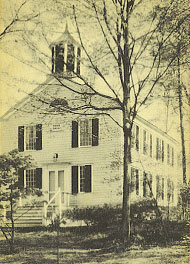 As soon as the first meetinghouse was built in 1726, Wilton had a "center" of town, although other areas such as Belden Hill, Drum Hill, Pimpewaug and Chestnut Hill had already been settled by self-sufficient farmers. By 1738 the first meetinghouse had become too small, and a second was built on the corner of Sharp Hill Road. Less than sixty years later, this second meeting house had fallen into such disrepair that a third church was built in 1790 on Ridgefield Road where it still stands as the oldest church building in Fairfield County, Connecticut.
As soon as the first meetinghouse was built in 1726, Wilton had a "center" of town, although other areas such as Belden Hill, Drum Hill, Pimpewaug and Chestnut Hill had already been settled by self-sufficient farmers. By 1738 the first meetinghouse had become too small, and a second was built on the corner of Sharp Hill Road. Less than sixty years later, this second meeting house had fallen into such disrepair that a third church was built in 1790 on Ridgefield Road where it still stands as the oldest church building in Fairfield County, Connecticut.
During the Revolutionary War, a surprisingly large number of over 300 men from Wilton served in a military unit. The War came to Wilton briefly in 1777 when the British had to retreat through the village after their invasion of Danbury. Although several Wilton houses were set afire, none were destroyed since the retreat was too rapid. About fifty-two Revolutionary veteran graves are still identifiable in Wilton cemeteries.
In 1802, despite Norwalk's objections, the people of Wilton sought and were granted separate Town government status by an act of the Connecticut General Assembly. The town chose the traditional New England Town Meeting-Selectmen form of government, which has been retained to this day.
In the nineteenth century, education became the responsibility of the school societies of nine separate school districts in Wilton. In addition, many Wilton children and those of well-to-do families of Norwalk and Stamford attended five private schools and academies in Wilton.
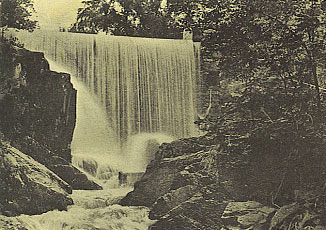 Wilton's population grew slowly from 1,728 in 1810 to 2,208 in 1860. Most of the land was farmland used for dairy herds, horses, or marketable crops. Farmers found their yield from the rocky soil to be very low at the same time that midwestern produce, made readily available by the railroads, began to compete with homegrown products, home industry expanded.
Wilton's population grew slowly from 1,728 in 1810 to 2,208 in 1860. Most of the land was farmland used for dairy herds, horses, or marketable crops. Farmers found their yield from the rocky soil to be very low at the same time that midwestern produce, made readily available by the railroads, began to compete with homegrown products, home industry expanded.
Industries such as shoemaking, shirt making, carriage building, and distilleries were common. Mills of various types were built along the streams and the Gilbert and Bennett Manufacturing Co. began producing wire sieves in 1834.
During the years prior to the Civil War, the antislavery movement was strong in town, and Wilton served as one of the stops on the Underground Railroad, a loosely organized escape route to Canada for runaway slaves. The Civil War itself, however, had little impact on Wilton, except that the continued success of local businesses was due largely to the demands of the war effort.
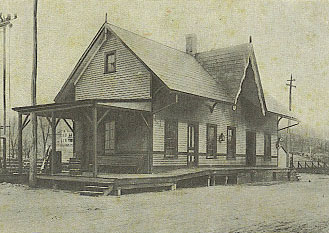 The coming of the railroad in 1852 did not bring many advantages to a community of home industry and farming; instead it offered easy access to the bountiful western lands. After the Civil War, Wilton's population declined as cities grew, industrialization increased, the market for home products dropped, and farms were abandoned. About 30% of the population was lost between 1860 and 1900. By 1900, the census showed only 1,598 people living in Wilton.
The coming of the railroad in 1852 did not bring many advantages to a community of home industry and farming; instead it offered easy access to the bountiful western lands. After the Civil War, Wilton's population declined as cities grew, industrialization increased, the market for home products dropped, and farms were abandoned. About 30% of the population was lost between 1860 and 1900. By 1900, the census showed only 1,598 people living in Wilton.
Today Wilton is grateful for this long dormant period in its history because it saved many of the eighteenth and nineteenth century homes from demolition and suburban development. Beginning in the 1910's, abandoned farms were discovered by New Yorkers for summer homes and in the 1930's, there were noticeable stresses at Town Meetings between the "old-timers" and the "new people." The community was changing from agricultural to one of commuters.
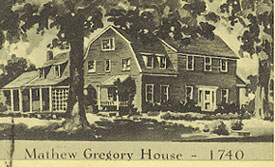 Originating in its colonial origins, Wilton had developed in a rather haphazard, individualistic way-a house here and a store there. Shortly after World War II, a new phenomenon brought a new look to Wilton's landscape-the builder subdivision.
Originating in its colonial origins, Wilton had developed in a rather haphazard, individualistic way-a house here and a store there. Shortly after World War II, a new phenomenon brought a new look to Wilton's landscape-the builder subdivision.
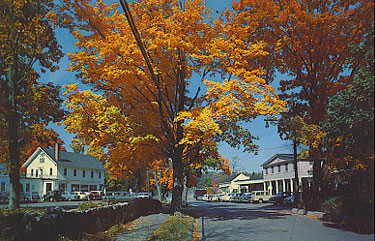 Light industry began moving into town. In order to plan for orderly growth, town zoning was adopted. With the growth in population and businesses came the corresponding need for new schools, new roads, executive offices, and more support services. The period of greatest growth was from 1950 to 1970, when the population grew from 4,558 to 13,572.
Light industry began moving into town. In order to plan for orderly growth, town zoning was adopted. With the growth in population and businesses came the corresponding need for new schools, new roads, executive offices, and more support services. The period of greatest growth was from 1950 to 1970, when the population grew from 4,558 to 13,572.
The transformation from a small farming town to a suburban residential community of approximately 18,000 has been carefully controlled by zoning and through the preservation of the town's older colonial landmarks.
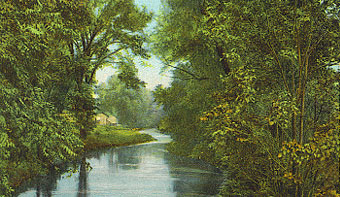 The town has had the foresight to preserve almost 1,000 acres of open space for active and passive recreational use. Although there is limited land remaining for development, Wilton retains much of its open feeling and rural atmosphere. Winding back roads with trees, streams, ponds, woods, and rolling hills are all part of the Wilton's beauty and charm and afford privacy as well as a pastoral setting.
The town has had the foresight to preserve almost 1,000 acres of open space for active and passive recreational use. Although there is limited land remaining for development, Wilton retains much of its open feeling and rural atmosphere. Winding back roads with trees, streams, ponds, woods, and rolling hills are all part of the Wilton's beauty and charm and afford privacy as well as a pastoral setting.
There exists among both new residents and those with established roots a strong commitment and concern that Wilton, whatever its future, shall retain some part of its rural heritage.
Other links of interest:
